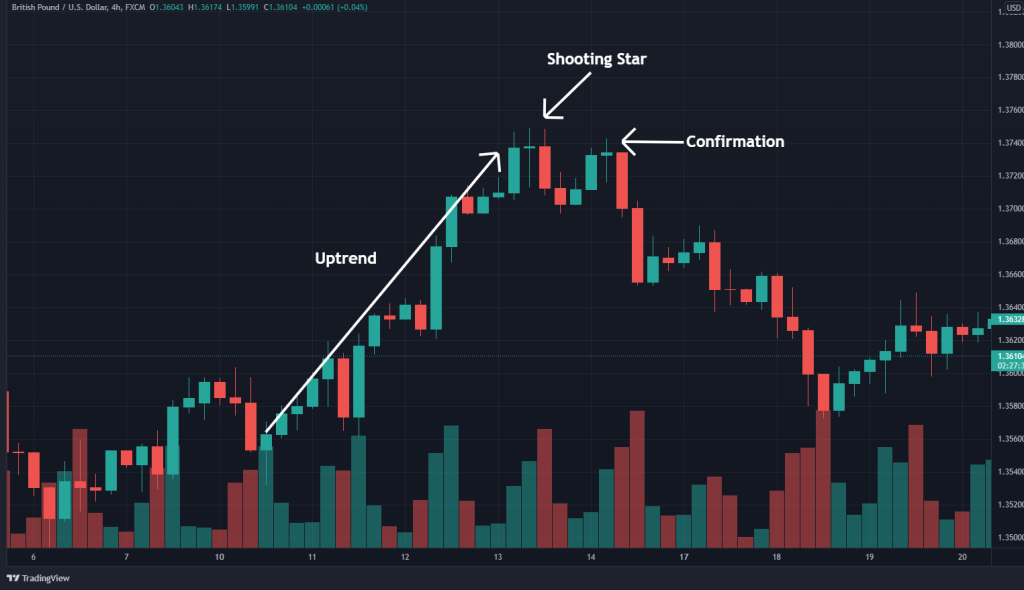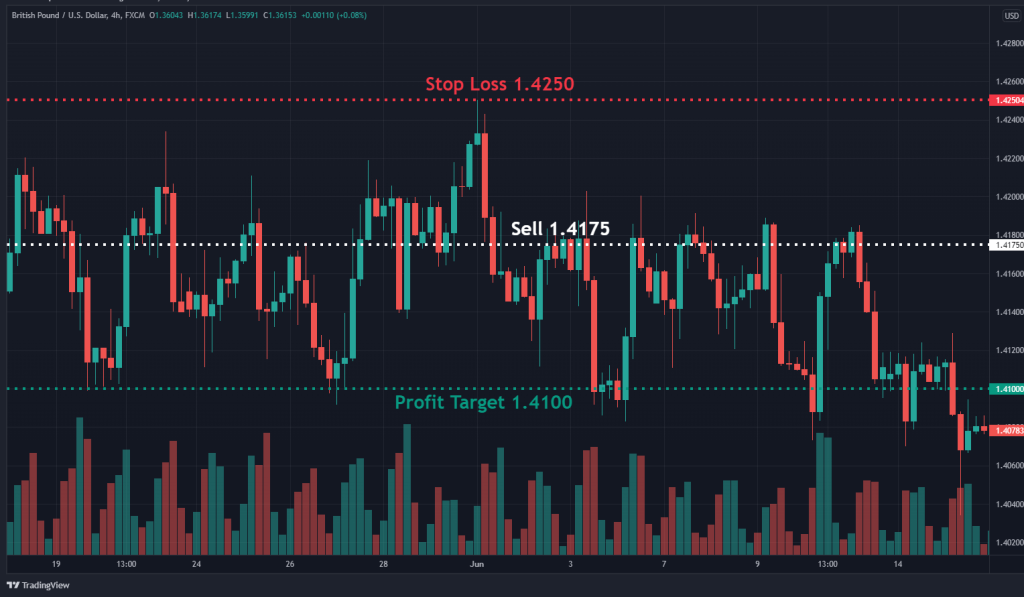
In this article, we will cover how to identify, interpret, and trade currency pairs with the evening star pattern. By the end, you’ll be able to apply the evening star to the forex markets in real time.
 Table of Contents
Table of Contents
What is the Evening Star Candlestick Pattern?
The evening star pattern is a reversal indicator that signals the end of an uptrend. The evening star consists of three consecutive candles: a large bullish candle, a Doji candlestick, and a large bearish candle.
Forex traders consider evening star patterns to be bearish reversal indicators. When the formation develops on a price chart, it is perceived as a signal to sell a currency pair.
How to Identify and Use the Evening Star Pattern in Forex Trading?
When trading forex, a specific process identifies and applies the evening star. First, you must recognize the formation of the evening star pattern. The GBP/USD chart below illustrates the evening star pattern.

The steps below define how to trade forex with the evening star candlestick pattern:
- Identify a strong uptrend
- Locate the formation
- Define a location for the sell order
- Place stop loss and profit targets
- Apply position risk management trading strategies
Recognition
As previously mentioned, the evening star is a three-candle bearish reversal pattern. It occurs during an upward trend on a price chart and is made up of three candles in succession:
- A large bullish candle
- A Doji candle (or similar)
- A large bearish candle
A vital component of all evening stars is the middle candlestick. The middle candle is a small candlestick or a Doji. This candle puts the “star” in the “evening star.”
Interpretation
Evening star patterns are classified as bearish reversal indicators. So, when they occur in the market, it is appropriate to look for shorting opportunities.
Many forex traders adopt a bearish market bias upon the evening star developing. Although the prevailing trend is up, they begin to favor sell-side trading strategies.
Combine for a Shooting Star
One advantage of using single candlestick patterns is that they may be combined with other formations in real time. In the case of the evening star, it may be extended into the shooting star candlestick pattern.
The shooting star candlestick pattern occurs when a subsequent Doji follows an evening star. The second Doji candle is considered to confirm the initial evening star reversal pattern. Below is a picture of the shooting star formation:

How to Trade the Evening Star Candlestick Pattern (in 3 Steps)?
Like other candlestick patterns, trading forex with evening star patterns is a breeze. All you need to do is recognize the formation (strong bullish candle — Doji — bearish third candlestick), define market entry, set a stop loss, and locate a profit target. Let’s see how it can be done:
1. Market Entry
Defining market entry with evening stars is a relatively straightforward process. A short trade location isn’t difficult to ascertain upon identifying the three-candle pattern.
To place a trade using evening stars, set a sell order beneath the third candle of the formation. When the order is executed, a new short position will become active.
2. Stop Loss
Because the evening star projects bearish reversals, your stop loss will be located above the pattern. Generally, the stop loss is located above the Doji candlestick. It is a buy order that cancels the short position if hit.
3. Profit Target
There are many ways to locate profit targets when trading FX chart patterns. A few of the most common are using risk vs. reward ratios or identifying potential support or resistance areas.
Remember, the evening star is used to predict downside market moves. So, profit targets are located beneath the pattern at a desirable level.
Trading Example
One of the premier benefits of single candlestick patterns is that they are easy to trade. Check out the GBP/USD example below for a real-world illustration of the process.

This GBP/USD evening star trade was executed as follows:
- An uptrend was observed.
- The evening star candlestick pattern was located.
- A sell order was placed beneath the formation at 1.4175.
- A stop loss was placed above the second candle at 1.4250.
- A profit target was located at 1.4100 according to a 1:1 risk vs. reward ratio.
- Upon the profit target being hit, the trade produced 75 pips profit.
Evening Star Pattern VS. Morning Star Pattern
The morning star pattern and the evening star formation have several key differences. Below are a few of the largest:
- The morning star is a bullish reversal pattern. It suggests the end of a prevailing downtrend.
- The evening star is a bearish reversal pattern. It indicates the end of a prevailing uptrend.
- The morning star identifies buying opportunities in the market.
- The evening star identifies selling opportunities in the market.
Although the evening and morning stars are three candlestick patterns, they are each a unique trading signal.
The Evening Star Pattern – Pros and Cons
These are the most common advantages and disadvantages of trading evening star patterns:
Pros
- Easy to identify
- Ideal for short-side FX trading strategies
- It may be traded on all products and time frames
Cons
- Can be expensive to trade on monthly, weekly, and daily charts
- Loses efficacy in rotational markets
- May produce false signals in strong bullish trends
Key Takeaways
In conclusion, here are the key takeaways:
 Key Points to Take Away
Key Points to Take Away
- The evening star pattern is a bearish reversal pattern. It comprises three candlesticks: a solid bullish candle, a small-bodied or Doji candle, and a long bearish candle
- The formation is a sell signal. To trade, a sell order is placed beneath the third candle, with a stop loss above the second candle (Doji). Profit targets are set beneath the pattern at the trader’s discretion
- An evening star is the opposite of the morning star candlestick pattern. It is a bearish formation, while the morning star is bullish.
Risk Disclosure: The information provided in this article is not intended to give financial advice, recommend investments, guarantee profits, or shield you from losses. Our content is only for informational purposes and to help you understand the risks and complexity of these markets by providing objective analysis. Before trading, carefully consider your experience, financial goals, and risk tolerance. Trading involves significant potential for financial loss and isn't suitable for everyone.



